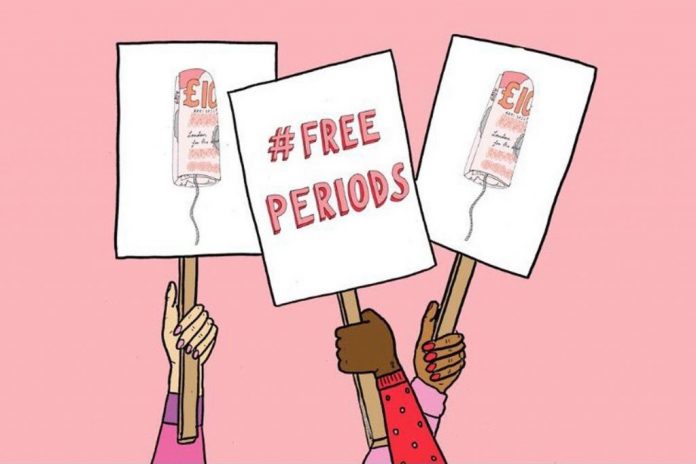The author made a request to remain anonymous.
The definition of period poverty includes not having access to supplies and information regarding menstruation. Period poverty also includes the stigma around menstruation stemming from cultural and social views. As a consequence of this lack of education and stigma around menstruation, many girls are not adequately knowledgeable about how to handle their own menstruations. Menstrual hygiene comprises of having access to clean menstrual products such as sanitary pads, access to private facilities for changing menstrual products, and proper disposal areas of used products. This is an especially difficult obstacle for refugee women as they might encounter potential problems with the procuring and disposal of pads.
In the United Kingdom, period poverty entails difficulties in accessing sanitary products. The difficulties are due to a lack of accessible free sanitary pads. During the pandemic, the lack of access to free products due to widespread institutional closure meant that places where girls and women would normally collect these supplies were further limited. As a result, many girls and women were forced to use alternatives such as rags, tissue paper, and newspapers. Access to information, space or encouragement to talk about menstruation as a normal function of the female body also decreased significantly. Therefore, the implementation of these spaces and encouraging open conversations is important to reduce the taboo of periods.
Half of the global refugee population are women and girls, which makes period poverty a topic that impacts a significant percentage of the population. In the absence of sanitary pads, different materials for sanitary pads are used; an important factor in the choice is the material’s durability. However, unwashed clothes are often used, which presents a high health risk. This highlights the clear lack of disposal and changing facilities for refugee women and girls, which has lasting impacts on the physical and mental health of those affected.
Cultural stigma also means that important educational information about menstruation is withheld or not communicated; many girls indicated that they were not aware of what menstruation was before their first period. This results only in distress and embarrassment, as well as the confusion of not understanding what is going on within one’s own body. Therefore, there is an evident need for further guidance regarding menstrual hygiene that is culturally appropriate.
We need to start thinking of more solutions to combat period poverty. These would include the provision of changing materials and privacy for showering with soap and water, and for washing stains from clothes and menstrual materials. Furthermore, there needs to be a proper disposal area with facilities that are widely accessible within refugee camps. If possible, research areas where you could donate or help to increase access refugees have to sanitary pads. One example would be the Hygiene Bank, where you can donate sanitary pads.
Bibliography
1.Astrup, J. (2018) PERIOD POVERTY Tackling the taboo – ProQuest [online]. Available from: https://www.proquest.com/docview/1987646421?fromopenview=true&pq-origsite=gscholar (Accessed 15 March 2022).
2. Korri, R. et al. (2021) Sexual and reproductive health of Syrian refugee adolescent girls: a qualitative study using focus group discussions in an urban setting in Lebanon. Reproductive Health. [Online] 18 (1), 130. [online]. Available from: https://doi.org/10.1186/s12978-021-01178-9 (Accessed 13 March 2022).
3. Plan International UK (2021) Over One Million Girls In The UK Struggled To Afford Or Access Period Products During The Pandemic [online]. Available from: https://plan-uk.org/media-centre/over-one-million-girls-in-the-uk-struggled-to-afford-or-access-period-products-during-the-pandemic (Accessed 13 March 2022).
4. Schmitt, M. L. et al. (2017) Understanding the menstrual hygiene management challenges facing displaced girls and women: findings from qualitative assessments in Myanmar and Lebanon. Conflict and Health. [Online] 11 (1), 19. [online]. Available from: https://doi.org/10.1186/s13031-017-0121-1 (Accessed 15 March 2022).
5. Sommer, M. & Sahin, M. (2013) Overcoming the Taboo: Advancing the Global Agenda for Menstrual Hygiene Management for Schoolgirls. American Journal of Public Health. [Online] 103 (9), 1556–1559. [online]. Available from: https://ajph.aphapublications.org/doi/abs/10.2105/AJPH.2013.301374 (Accessed 13 March 2022).
6. Michel, J. et al. (2022) Period poverty: why it should be everybody’s business. Journal of Global Health Reports. [Online] [online]. Available from: https://www.joghr.org/article/32436-period-poverty-why-it-should-be-everybody-s-business (Accessed 13 March 2022).
7. VanLeeuwen, C. & Torondel, B. (2018) Improving menstrual hygiene management in emergency contexts: literature review of current perspectives. International Journal of Women’s Health. [Online] 10169–186. [online]. Available from: https://www.ncbi.nlm.nih.gov/pmc/articles/PMC5901152/ (Accessed 13 March 2022).
[Image taken from Feminism in India.]
